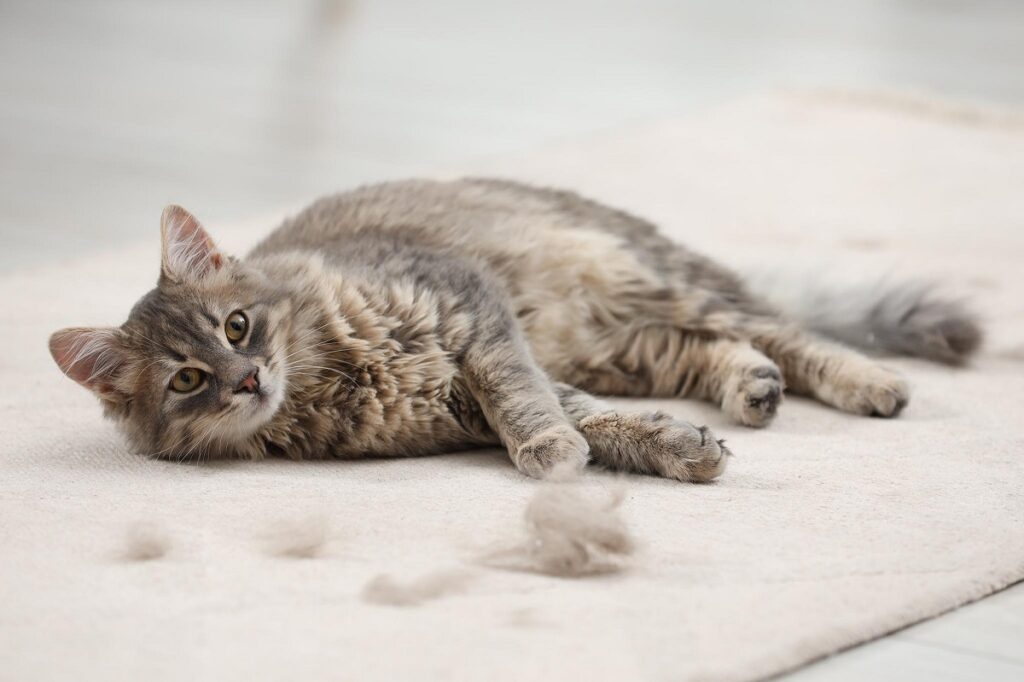Have you noticed your cat losing more hair than usual? While some shedding is normal, excessive hair loss can be a sign of an underlying issue. Cats can lose hair for a variety of reasons, from allergies and parasites to medical conditions and stress. If you’re wondering why your feline friend is experiencing bald spots or thinning fur, this guide will help you understand the potential causes and what you can do about it.
Common Causes of Cat Hair Loss
There are many reasons why cats lose hair. Understanding the cause is key to finding the right treatment. Below are the most common culprits behind feline hair loss.
Allergies and Skin Irritations
Just like humans, cats can have allergic reactions to certain foods, environmental factors, or fleas. Allergies often lead to intense itching, which results in excessive grooming and hair loss.
Signs of Allergies in Cats:
- Red, inflamed skin
- Frequent scratching or licking
- Hair thinning or bald patches
- Runny nose or watery eyes (in some cases)
Common Allergens:
- Flea bites (flea allergy dermatitis)
- Certain foods (e.g., dairy, fish, grains)
- Pollen, dust, mold, and other environmental factors
Parasites: Fleas, Mites, and More
Parasites are a common cause of hair loss in cats. Fleas, mites, and even lice can make your cat’s skin itchy, leading to excessive scratching and hair thinning.
Symptoms of Parasite Infestation:
- Intense scratching and biting at the skin
- Small red bumps or scabs
- Visible fleas, flea dirt, or mites in the fur
- Hair loss, especially near the tail and neck
Treatment: Flea prevention treatments, medicated shampoos, and regular grooming can help eliminate parasites and reduce hair loss.
Stress and Overgrooming
Cats are sensitive creatures, and stress can lead to compulsive behaviors, including overgrooming. This is known as psychogenic alopecia, where stress triggers excessive licking, resulting in hair loss.
Common Stress Triggers:
- Moving to a new home
- Introducing a new pet or family member
- Changes in routine or environment
- Lack of mental or physical stimulation
How to Identify Overgrooming:
- Bald patches, especially on the belly, legs, and sides
- No visible skin infection or parasites
- Grooming even when relaxed
Fungal and Bacterial Infections
Fungal infections like ringworm and bacterial skin infections can cause significant hair loss in cats.
Symptoms of Ringworm:
- Circular bald patches with red, scaly edges
- Dry, flaky skin
- Brittle or broken hairs
- Contagious to humans and other pets
Bacterial infections may result from untreated wounds, leading to localized hair loss, redness, and swelling.
Hormonal Imbalances and Medical Conditions
Hormonal disorders and other medical conditions can also contribute to hair loss in cats. Some of the most common include:
- Hyperthyroidism: Overactive thyroid leads to hair thinning and excessive shedding.
- Cushing’s Disease: Excessive steroid production results in hair loss, fragile skin, and increased thirst.
- Diabetes: Can cause skin issues and poor coat health due to metabolic changes.
If you suspect a medical condition, a vet consultation is essential for proper diagnosis and treatment.
How to Treat and Prevent Hair Loss in Cats
Identifying and Treating Allergies
- Switch to a hypoallergenic diet if food allergies are suspected.
- Keep your home free of dust and pollen.
- Use flea preventatives year-round.
Managing Parasites and Skin Infections
- Regularly check your cat for fleas and mites.
- Use vet-recommended flea treatments.
- Treat fungal infections with antifungal medications.
- Keep bedding and furniture clean to prevent reinfestation.
Reducing Stress and Behavioral Issues
- Provide a stable environment with minimal changes.
- Use calming pheromone diffusers like Feliway.
- Ensure your cat has enough mental stimulation through toys and playtime.
When to See a Vet
If your cat’s hair loss is severe, persistent, or accompanied by other symptoms like weight loss, lethargy, or skin infections, a vet visit is necessary. Early diagnosis can prevent serious complications.
Conclusion
Hair loss in cats can stem from various causes, including allergies, parasites, stress, infections, and medical conditions. Identifying the root cause is essential for proper treatment and prevention. If your cat is experiencing unusual hair loss, don’t ignore it—take action to ensure their health and well-being.
FAQs
1. Can hair loss in cats be seasonal?
Yes, some cats experience seasonal shedding, but if the hair loss is excessive or patchy, it may indicate an underlying issue.
2. How can I tell if my cat’s hair loss is due to stress?
If your cat is grooming excessively, has bald spots in specific areas, and there are no visible skin infections or parasites, stress might be the cause.
3. What home remedies can help with hair loss in cats?
A healthy diet, flea prevention, regular grooming, and stress-reducing techniques like interactive play can help reduce hair loss.
4. Can diet affect my cat’s hair loss?
Yes, a poor diet can lead to hair thinning. Providing high-quality, protein-rich food with essential fatty acids can improve coat health.
5. Is cat hair loss always a sign of illness?
Not always. Some shedding is normal, but if hair loss is excessive, patchy, or accompanied by other symptoms, it’s best to consult a vet.

